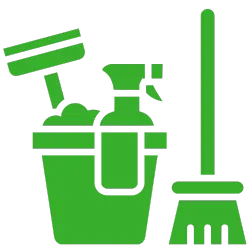Water Tank Cleaning Price in Pakistan in 2025
Water Tank Cleaning Price in Pakistan
What Competitors Are Charging: Price Surveys & Real Examples
Sample Detailed Price Breakdown (Hypothetical Cases)
How Often Should You Get It Cleaned?
Tips to Reduce Cost without Compromising Quality
Water tanks are essential in Pakistani households and businesses, especially given irregular supply and water quality concerns. But many people underestimate the importance of cleaning & maintaining these tanks. A dirty tank can degrade water quality, promote algae growth, cause foul smells, create health hazards, and reduce the lifespan of the tank.
One of the most commonly asked questions is: How much does it cost to have a water tank cleaned in Pakistan? The answer isn’t fixed, it depends on many variables. In this post, I’ll break down the average costs, what competitors are charging, what influences the price, and how you can make a good decision when choosing a service.
What Competitors Are Charging: Price Surveys & Real Examples
I gathered data from various service providers across Pakistan, Lahore, Islamabad, Karachi mostly — to show you what people are actually paying. These examples provide context so you can evaluate quotes more confidently.
Average Price Ranges & Typical Charges
From the competitor data, here are rough average price bands you can expect, depending on the tank size, material, and conditions:
So in short: for a typical household plastic overhead tank, expect somewhere between PKR 1,500 to 6,000 based mostly on size and condition. For bigger or more complex cases, it can go higher.
FIND THE BEST UNDERGRAOUND AND ROOF WATER TANK CLEANING SERVICES HERE
What Factors Affect the Price
Why do different companies quote very different rates? Here are the main factors that cause variation:
Tank Size (Capacity / Volume / Footprint)
The single biggest factor. Cleaning a 300-gallon tank is very different (in labour, time, water, chemicals) from cleaning a 5000-L or an underground concrete tank.Tank Material & Type
Plastic / polyethylene tanks are easier and cheaper.
Cement / concrete (especially underground) are harder: more scraping, more effort to remove slime, algae, rust or sediment.
Metal tanks (steel, galvanized, etc.) may have rust or require anti‐corrosion treatment.
Condition / Dirtiness Level
If a tank has been neglected for a long time, with sludge, algae, foul smell, or thick sediment, cleaning requires more labour, more time, possibly extra chemicals. This increases cost.Type of Cleaning Process
Basic cleaning (drain water, scrub, re-fill) is cheaper.
Deep cleaning: high pressure jet wash, vacuum or sludge removal, disinfection (chlorination or chemical), drying, inspection.
Additional services: pipe cleaning, repairing leaks, replacing lids/grills, etc.
Accessibility / Location
If the tank is hard to reach (on a rooftop, underground, in a crowded building), labour/time increases. Transport of staff / tools or bringing water may add extra cost.Frequency / Regular Maintenance
If you have a contract or regular cleaning (e.g. every 6 months), companies might offer lower per-cleaning rates. A neglected tank cleaned once in 2-3 years will cost more.Geographical City / Market Conditions
Rates in Karachi, Lahore, Islamabad might differ. Costs of labour, cost of sanitizing chemicals, transportation differ by city. Also competition and demand matter.Additional Safety / Hygienic Measures
Use of quality disinfectants, chemicals safe for drinking water, personal protective equipment, ensuring chemical residues are fully washed out — these add cost but are important.
Sample Detailed Price Breakdown (Hypothetical Cases)
To help you understand, here are some sample scenarios with estimated costs:
How Often Should You Get It Cleaned?
To maintain good water quality and prevent problems, here are typical guidelines:
Residential overhead plastic tanks: At least once a year; ideally every 6 months if water supply is irregular or water quality is poor.
Concrete / underground tanks: More frequent inspection, cleaning every 6-12 months depending on usage & water quality.
After heavy rain, flooding, or if you notice symptoms: foul smell, discolored water, insects, algae growth etc., clean immediately.
Regular maintenance reduces cost in long term (because less sludge buildup, less damage, fewer emergency repairs).
What You Should Get / Ask When Hiring a Service
To ensure good quality and fair pricing, when you contact tank cleaning services, ask/ensure the following:
On-site inspection & quote
The company should visit, look at the tank, assess its condition, measure size, see the access etc., before giving a firm quote. If they quote over phone without seeing, it might be inaccurate or result in extra charges later.Transparent components of the cost
Ask what they include: labour, chemicals/disinfectants, sludge removal, high pressure washing, vacuum cleaning, repairs, refill water etc. Also ask about safety measures.Chemicals used & safety / potable water compatibility
If cleaning with chemicals, they must be safe for drinking water; after cleaning there must be rinsing and no harmful residues left.Before & after proof
Some reputable companies provide before/after photos, or water quality testing after cleaning (if requested) to show effectiveness.Guarantees or follow-up service
If within a certain period something goes wrong (smell returns, leaks etc.), will they come back or offer a check up?Proper licensure / reputation / reviews
Check reviews, ask neighbors, check past clients. A very cheap service may under-deliver (bad cleaning, missed spots, residue issues etc.)Check if extra work is likely
If tank lid is broken, if there are leaks, if pipes feeding the tank are dirty – these often add to cost.
Tips to Reduce Cost without Compromising Quality
Clean regularly (every 6-12 months) to prevent massive buildup — easier and cheaper to clean a lightly dirty tank than one full of sludge.
Do basic maintenance yourself in between professional cleanings: keep lids closed, prevent debris entering, remove visible algae, ensure inlet filters are clean.
Compare quotes from at least 3 providers; sometimes local ones are much cheaper than big brands.
Ask for discounts or package deals especially if you have multiple tanks or need regular cleaning.
Ensure the provider includes all necessary work; a cheaper quote might omit disinfection or proper drying.
Why Under-Priced Services Are Risky
Sometimes very low quoted prices may seem tempting. But be wary because:
They might use low-quality chemicals or minimal cleaning, which won’t properly remove bacteria, algae, sludge.
May skip disinfection or thorough UV/chemical cleaning.
Could damage the tank with improper scrubbing or harsh agents.
Might leave residues or not properly rinse, leading to bad odor or health risks.
Spending a reasonable amount ensures you get clean, safe water, which has health benefits that outweigh the extra cost.
Conclusion
The cost to clean a water tank in Pakistan varies widely depending on size, material, condition, location and type of cleaning needed. For a small plastic overhead tank, expect PKR 1,500-3,500; for medium or cement tanks, PKR 4,000-8,000+; for large, underground or commercial tanks, PKR 10,000-25,000+ or more if extensive work is needed.





